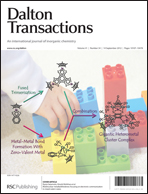Nickel complexes supported by quinoline-based ligands: synthesis, characterization and catalysis in the cross-coupling of arylzinc reagents and aryl chlorides or aryltrimethylammonium salts†
Abstract
Lithium and nickel complexes bearing ![[double bond, length as m-dash]](https://www.rsc.org/images/entities/char_e001.gif) N(8-C9H6N) (1a, R = p-MeC6H4; 1b, R = But. C9H6N = quinolyl)). Reaction of 1a with (DME)NiCl2 generates a nickel complex [NiCl2{N(8-C9H6N)
N(8-C9H6N) (1a, R = p-MeC6H4; 1b, R = But. C9H6N = quinolyl)). Reaction of 1a with (DME)NiCl2 generates a nickel complex [NiCl2{N(8-C9H6N)![[double bond, length as m-dash]](https://www.rsc.org/images/entities/char_e001.gif) P(Ph2)NH(p-MeC6H4)}] (2a). Treatment of 1b with (DME)NiCl2 and following with NaH produces [NiCl{(1,2-C6H4)P(Ph)(NHBut)
P(Ph2)NH(p-MeC6H4)}] (2a). Treatment of 1b with (DME)NiCl2 and following with NaH produces [NiCl{(1,2-C6H4)P(Ph)(NHBut)![[double bond, length as m-dash]](https://www.rsc.org/images/entities/char_e001.gif) N(8-C9H6N)}] (4). Complex 4 was also obtained by reaction of (DME)NiCl2 with [Li{(1,2-C6H4)P(Ph)(NHBut)
N(8-C9H6N)}] (4). Complex 4 was also obtained by reaction of (DME)NiCl2 with [Li{(1,2-C6H4)P(Ph)(NHBut)![[double bond, length as m-dash]](https://www.rsc.org/images/entities/char_e001.gif) N(8-C9H6N)}] (5) prepared through lithiation of 1b. Reaction of 2-PyCH2P(Ph2)
N(8-C9H6N)}] (5) prepared through lithiation of 1b. Reaction of 2-PyCH2P(Ph2)![[double bond, length as m-dash]](https://www.rsc.org/images/entities/char_e001.gif) N(8-C9H6N) (6, Py =
N(8-C9H6N) (6, Py = ![[double bond, length as m-dash]](https://www.rsc.org/images/entities/char_e001.gif) C(Ph)CH2P(Ph2)
C(Ph)CH2P(Ph2)![[double bond, length as m-dash]](https://www.rsc.org/images/entities/char_e001.gif) N(8-C9H6N) (8), respectively, with (DME)NiCl2 yields two five-coordinate N,N,N-chelate nickel complexes, [NiCl2{2-PyCH2P(Ph2)
N(8-C9H6N) (8), respectively, with (DME)NiCl2 yields two five-coordinate N,N,N-chelate nickel complexes, [NiCl2{2-PyCH2P(Ph2)![[double bond, length as m-dash]](https://www.rsc.org/images/entities/char_e001.gif) N(8-C9H6N)}] (7) and [NiCl2{PhN
N(8-C9H6N)}] (7) and [NiCl2{PhN![[double bond, length as m-dash]](https://www.rsc.org/images/entities/char_e001.gif) C(Ph)CH2P(Ph2)
C(Ph)CH2P(Ph2)![[double bond, length as m-dash]](https://www.rsc.org/images/entities/char_e001.gif) N(8-C9H6N)}] (9). Similar reaction between Ph2PCH2P(Ph2)
N(8-C9H6N)}] (9). Similar reaction between Ph2PCH2P(Ph2)![[double bond, length as m-dash]](https://www.rsc.org/images/entities/char_e001.gif) N(8-C9H6N) (10) and (DME)NiCl2 results in five-coordinate N,N,P-chelate nickel complex [NiCl2{Ph2PCH2P(Ph2)
N(8-C9H6N) (10) and (DME)NiCl2 results in five-coordinate N,N,P-chelate nickel complex [NiCl2{Ph2PCH2P(Ph2)![[double bond, length as m-dash]](https://www.rsc.org/images/entities/char_e001.gif) N(8-C9H6N)}] (11). Treatment of [(8-C9H6N)N
N(8-C9H6N)}] (11). Treatment of [(8-C9H6N)N![[double bond, length as m-dash]](https://www.rsc.org/images/entities/char_e001.gif) P(Ph2)]2CH2 (12) [prepared from (Ph2P)2CH2 and 2 equiv. of
P(Ph2)]2CH2 (12) [prepared from (Ph2P)2CH2 and 2 equiv. of


 Please wait while we load your content...
Please wait while we load your content...